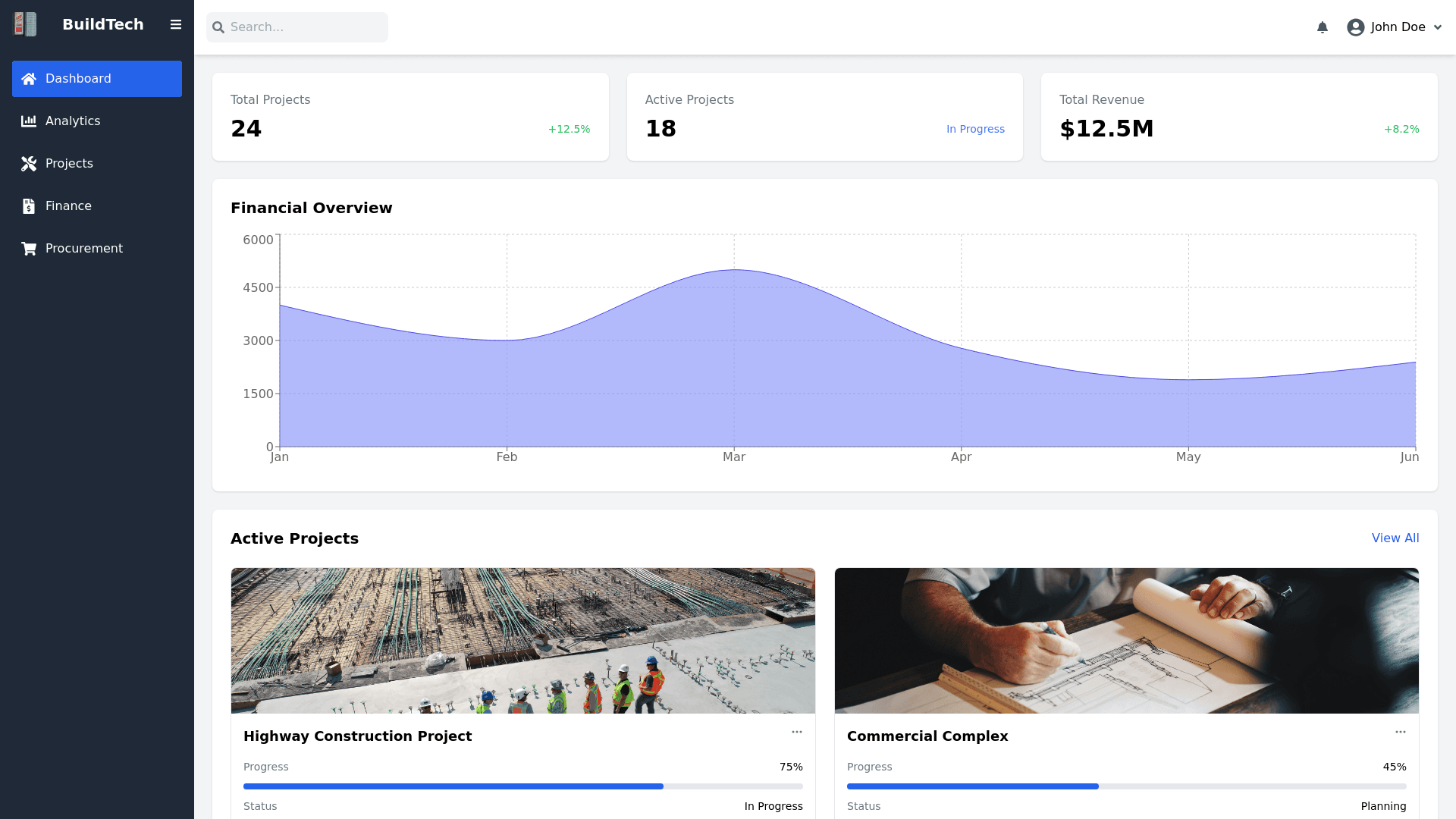Construction Platform - Copy this React, Tailwind Component to your project
Project Overview: Design a user interface (UI) and user experience (UX) for a comprehensive platform tailored for managing a construction company’s operations, finances, and workflows. The platform should be intuitive, visually appealing, and allow for seamless navigation between various functionalities. Core Sections and Functionalities 1. Company Management Financial Overview: Dashboard with summarized financial insights related to construction projects. Company Branding: Settings for managing company details, logo, and branding. Access Control: Role based employee access and permissions. Collaboration: Tools for shared access to corporate data. Directory Management: Centralized directory for contractors and clients. Inventory & Materials: Warehouse management system for inventory tracking. Inventory Audits: Features for conducting inventory checks. Corporate Procurement: Tools to manage company wide purchases. Multiple Legal Entities: Support for managing multiple legal entities under one platform. Corporate Finances: Payment tracking and financial management tools. Bank Integrations: Integration with financial institutions for seamless transactions. Financial Reports: Cashflow and P&L (Profit and Loss) reporting tools. Data Backup: Automated email backups for critical data. API Support: Integration options for third party tools. 2. Construction Project Management Project Titles: Clear identification and labeling of construction projects. Financial Analytics: Tools for in depth financial analysis per project. Summary Reports: Consolidated financial overviews for budgets and estimates. Measurements & Progress: Tools for site measurements and work progress tracking. Collaboration: Shared project and estimate access among team members. Photo Documentation: Capability to upload and view construction progress images. Project Creation: Options for employees to create and manage projects and budgets. File Storage: Central repository for project documentation and blueprints. 3. Planning and Sales Estimate Editor: Comprehensive tools for creating and editing estimates. Procurement & Work Assignments: Features for assigning and tracking tasks. Data Import: Import options for estimates from Excel and other formats. Software Integration: Compatibility with cost estimation software (e.g., GRAND Smeta, SmetaWIZARD). Proposal Approvals: Streamlined workflows for client proposal approvals. Payment Plans: Customer payment scheduling and tracking. Planning Timeline: Tools for creating project schedules. 4. Pricing Database Custom Pricing: Creation and management of custom pricing lists. Pricing Updates: Synchronization with regional pricing guides. Technological Cards: Support for manufacturers' technical specifications. Regional Pricing: Pricing database for materials and services in Russia and CIS. Operations Management: Management of operational and technological maps. Collaboration: Shared access to pricing references. Read Only Access: View only mode for non editable pricing data. 5. Construction Organization Work Monitoring: Real time tracking of subcontractor performance. Mobile Access: Mobile apps for field use. Procurement Management: Tools for managing orders and supplies. Foreman’s Workspace: Mobile dashboard for on site managers. Budget Oversight: Tools for controlling budget allocation and spending. Subcontractor Payments: Calculations for subcontractor payouts. Additional Work Records: Documentation of extra tasks and work adjustments. Client Payments: Tools for managing client transactions. Client Communication: Chat features for client discussions, file exchanges, and project updates. Client Portal: Dedicated space for clients to view project progress and details. Document Templates: Pre designed and custom document templates for reporting and invoicing. Comments with Attachments: Ability to add files in comment sections. Resource Payments: Requests for resource payment approvals. Expense Tracking: Management of petty cash and on site expenditures. 6. Procurement and Supply Chain Management Planning & Budgeting: Tools for scheduling, tracking, and budgeting purchases. Profit Analysis: Features to monitor profitability on supplied materials. Task Distribution: Task assignment capabilities for procurement teams. Financial Metrics: Dashboard for tracking procurement department performance. Supplier Price Requests: Streamlined workflows for gathering supplier quotations. Product Catalogs: Catalog management with real time pricing updates. Subcontractor Purchases: Monitoring and managing subcontractor related orders. Receipt Management: Optical character recognition (OCR) for receipt scanning and storage. Receipt Reporting: Automatic generation of reports based on receipts. Material Requests: Tools for site managers to request materials. Payment Approvals: Features for approving procurement related expenses. Centralized Purchasing: Consolidation of company wide purchasing. 7. Work Completion and Reporting Automated Reports: Auto generated reports for completed work. Financial Reconciliations: Tools for managing contractor payment reconciliations. Client Reports: Automatic generation of receipt based reports for clients. Document Templates: Pre designed forms for KС 2, KC 3, KC 6a, and custom reports. Additional File Attachments: Capability to include files in comments or specific report sections. Design Requirements: Modular Layout: Each functional area should have a distinct, modular design for intuitive navigation. Responsive Design: Ensure compatibility with both desktop and mobile devices. Data Visualization: Use dashboards, charts, and graphs for financial and project overviews. Collaboration Focus: Include shared access features with role based permissions. Streamlined Workflows: Provide guided workflows for tasks like procurement, reporting, and approvals. Clean Aesthetic: Use a professional and minimalistic design to reduce cognitive load.
